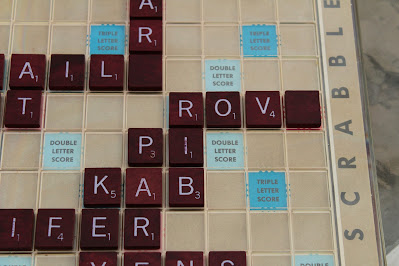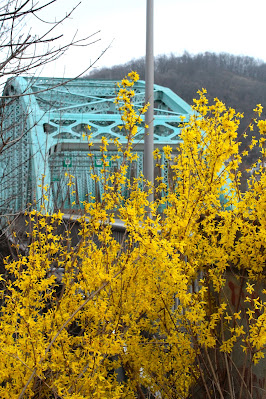Our day started out before the sun was up. We finally saw it
as it shone into our eyes as we drove into the east, appearing from behind some
hills to blind us with its brilliance. The air outside the car was cold, below
freezing but inside the car the sun quickly warmed us up. We were out to see
what we could find on that one day of the year which happens…only once every four
years.
We stopped for some coffee and tea and then, a bit further
down the road, stopped for a couple donuts. We timed the stop JUST right, they
came out fresh from the back room as we entered the bakery. Fingers a bit sticky from
icing we returned to the warmth of the sun and the possibilities we might
encounter.
We drove along at a moderate speed as those who were heading
towards work sped past us. We weren’t in a hurry; we had the whole day ahead of
us. Our journey wasn’t that far, just into the outskirts of Blairsville. Just a
hop, skip and a jump compared to some of our other escapades.
A few stops were made to snap pictures and soon we were at
our destination, a parking spot on the edge of a State Game Lands. A short walk
up the road would take us to an old road leading eventually to an old, abandoned limestone quarry.
Standing in the cold air we put on our boots and gloves and
our safety orange hats. I strapped my camera gear onto my back, strung a camera
around my neck and we grabbed our hiking staffs and hit the trail. The
temperatures were still below freezing and the water that ran along the dirt
road was frozen in many places. The road was wide enough for a car to travel
but whether or not you would want to…that was another question. Vines leaned
out into the path and a tree hung over top of it, held up only by vines. I’m
happy with the fact we left the car behind.
Our walk would take us past a few geocaches, of course. In
fact it was a cache that brought us here. Reading the description of one of
them spiked my interest, who wouldn’t want to see big limestone caves?
Starting our stroll, the sounds of the barking dogs in the
houses near our car gradually disappeared as the sounds of the near-by stream
replaced them. The sounds of the water rushing over the rocks were wonderful!
We came across a large cement structure rather quickly. It
appeared boxlike but as we neared it we could see it was two thick parallel
walls. Heavy I beams connected the two walls above. On the sides, six openings
with triangular tops broke the walls, large enough for a person to walk
through. Inside was one of the I beams and the roots of a very large tree which
had fallen many years before.
We had seen structures like this near Dunbar, not far from
mines. I’m guessing it might have been some sort of rock crusher or loader. A
truck could easily drive through the ends. On the backside, bolts, complete
with nuts and washers hung from the walls where something used to be attached.
Concrete mounts or foundations were scattered around in the woods near-by, all
the equipment long gone. I can only guess and wonder.
The road varied between gravel and muddy ruts. In places the
vines, heavy with thorns reached out at our eyes and clothes. The stream came
closer to the path and the noise increased, a pleasant, soothing noise. At times
it was loud and forceful and at other times, soft and just barely noticeable.
Occasional forays into the sides of the trail were necessary
to look for geocaches. We had a list of 6 on our GPS for this route. Since it
wasn’t quite spring yet, it was easy making our way through the weeds. We could
see the limbs and stones we had to cross, most of the weeds were still low to
the ground. The gloves and jacket I was wearing helped repel the thorns bushes
we ran into. Forsythia bushes showed young leaves on their branches, partially
opened but their bright green color was dulled by the recent cold weather.
The final ¼ mile of the trail increased its pitch, near the
top, we encountered a field. Yellow grasses covered some portions and slanting
sheets of stone covered others. Puddles of frozen water sat on the rocks. To
our left, we could see high rocky crags and a bit further up we could see the
black openings of caves.
The entrances were huge, 20 or 30 feet high. Inside the
floors were a jumble of rocks, some piled as a hindrance to vehicles and others
debris from the ceilings above. The caves were connected and had large stone
columns which helped hold up the roof.
In October of 2020 the US Geological Survey noted a 2.9
tremor near here, a possible earthquake. Further study determined it was the
collapse of multiple columns in an abandoned section of quarry. The sound and
vibrations were strong enough to register on a seismograph! Whether or
not it was here, I don’t know.
It had to be exciting to see how these caves were made. They
followed the slant of the hillside; the next cave was a bit higher than the one
preceding it. We could see the strata of the different type of rocks in the
cliff face, all with the same slope to them.
At the top of the open field we could see behind us one of
the neighborhoods of Blairsville in the distance. We searched around in the
rocks for a geocache but came up empty. It was supposedly inside a large 5
gallon bucket, we couldn’t have missed it. So, we returned to the caves and sat
down and ate an apple and enjoyed the view.
I wasn’t upset about not finding the cache, this often
happens. The nice thing about this particular cache was that it brought us here
to this really cool site. Caves and cliffs, free from graffiti, a wonderful
view and lots of fresh air with the occasional sounds of train whistles drifting up
to us from the valley below. The skies were blue with puffy white clouds
drifting by and the temperatures were rising. Could it be any better?
Back at the car we talked about getting some lunch. Heading
towards Blairsville we passed a sign advertising Annabelle Books. We couldn’t
pass up a book store so we turned around to find it. We drove up a long
driveway to a nice looking house, wondering if this was the place. As we
pondered whether or not to knock, a woman came out and asked if we needed any
help.
It wasn't a bookstore, but they did sell her husband's books. We were invited in and soon were sitting and talking with
Stella and Paul. Paul is a marine scientist and an author and Stella a well
known cook and artist. The pair has lived an exciting life, traveling around
the world, raising Weimaraners and living on a beach in Mississippi. Their
lives also had some downfalls, including being forced out of their home when Hurricane
Katrina hit land in 2005. This eventually brought them up to Stella’s family
farm in Pennsylvania. Truly an exciting life!
We sat and talked for a while before we had to leave. It was
another good experience we had during the day. Thank heavens we had seen the
sign, otherwise we would’ve never met these two nice people and heard some of
the stories of their lives. We left with a couple of Pal's books.
The BBQ at Clem’s Café pulled us in for lunch. Chances
are you’ve seen their pig sitting on top of their building along rt.22. It’s
well worth the stop as long as you’re not a vegetarian, though they do have
some good macaroni and cheese!
There were a few more caches on our way back and we stopped briefly
at the Loyalhanna Dam. A nice leisurely drive took us through the back roads of
Westmoreland County. Soon we were back on the fast moving roads of Alleghany.
Enjoying a beautiful day, we found 8 of the 10 caches we
looked for, 80%, not bad at all! We found and visited a really neat set of
caves, had a great walk in the woods and met two nice people who shared some of
their lives with us. It was a great way to spend that one day that we get, only
once every four years!
A final note; my daughter told me about Leap Day William who
lives in the Mariana Trench. He emerges once every four years to change children’s
tears into candy. Wearing blue and yellow and eating rhubarb is part of his
tradition. This came from an episode of the show, 30Rock. Neither Ann Marie or
I had anything yellow to wear, (imagine a Pittsburgher saying that) so we opted
for our orange safety caps along with our blue jeans. There was no rhubarb in
our day either. We didn’t see L.D.William but we did talk about him more than
once during our day. He says that anything done on February 29th doesn’t
count because real life can wait for March. We have to disagree because we will
remember this day… for a long time!











1873%20.jpg)
.jpg)








.jpg)









.jpg)



.jpg)



.jpg)


.jpg)


.jpg)


